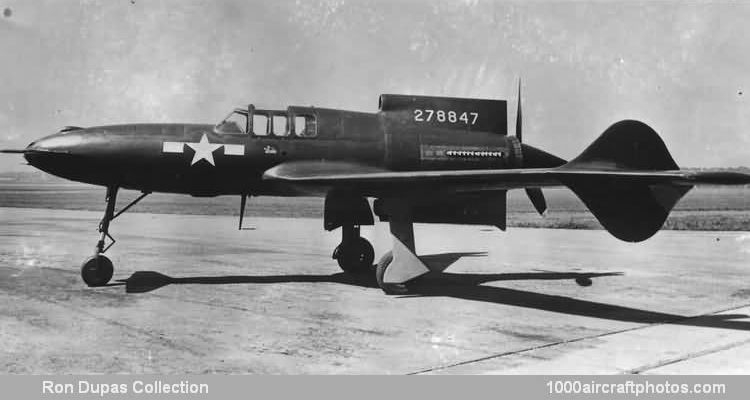07/31/2011. Remarks by Johan Visschedijk: "In 1940, the US Army decided to break away from its traditional evolutionary approach to the development of fighter aircraft and invited the industry to submit unorthodox design proposals. Curtiss-St. Louis responded with studies of the Model CW-24, a single-seat swept-wing pusher Pursuit with canard elevators, the new 2,200 hp Pratt & Whitney X-1800 (H-2600) engine, and the first application of tricycle landing gear to a Curtiss military aircraft.
It should be pointed out that the canard design had serious aerodynamic shortcomings and had even been rejected by the Wright brothers, who in 1910 converted to designs with all the elevating and stabilizing surfaces behind the wing. While sporadic attempts were made subsequently by other designers to capitalize on some of the canard's known advantages, the inherent disadvantages outweighed them every time. The Curtiss proposal of a canard fighter under these circumstances was a daring move indeed and was accepted with misgiving by the Army. A contract for further data, a wind-tunnel test model, and an option for one prototype was awarded on June 22, 1940.
Since the Curtiss entry was rated below some of the others, the Army soon lost interest and withdrew support. Curtiss then decided to develop the design on its own and built a simplified full-scale flying mockup under the designation CW-24B. This was a light-weight low-powered mockup of the proposed fighter built quickly of wood and fabric and powered with a commercial 275 hp Menasco C-6S-5 engine. This was shipped to the Army flight-test center on Muroc Dry Lake in California, where it made its first flight on December 2, 1941.
Performance was low with only 275 hp, but the CW-24B proved the feasibility of the unorthodox design. After various modifications that included addition of dorsal and ventral fins, enlargement of the original vertical fins and their relocation 4 ft (1.21 m) farther outboard, plus the lengthening of the wing tips, the CW-24 flight program was completed in May 1942. The aircraft, with Army serial number 42-39347 assigned, was then shipped to Langley Field, Hampton, Virginia, for further study by the NACA laboratories.
During the flight program of the CW-24B, design work went ahead on the proposed fighter version and a contract for three XP-55s was received on July 10, 1942. Since the Pratt & Whitney X-1800 engine did not materialize, the engine chosen was the 1,275 hp Allison V-1710-95.
The first XP-55, Army serial 42-78845, was essentially like the finalized CW-24B. First flight was on July 19, 1943, from the Army's Scott Field near the St. Louis plant. Some of the inherent stability problems of canards, amplified by the high fighter wing loading, soon appeared. The first XP-55 was lost on November 15, 1943, when the pilot could not recover from a stall and took to his parachute after falling out of control for 16,000 ft (over 4,800 m).
The second XP-55, 42-78846, was too far on to be conveniently modified in the light of the first XP-55's experience so was flown under restrictions (including prohibition of stalls below 20,000 ft (6,096 m)) starting on January 9, 1944.
The pictured third aircraft was modified to include greater forward elevator travel and had the wing span increased by 4 ft (1.21 m), and was fitted with the designed complement of four forward-firing 0.50 in (12.7 mm) machine guns and used for gunnery and performance tests. First flight was on April 25, 1944.
The official name, Ascender, originated in jest by a Curtiss engineer, was not new with the XP-55, having been applied for obvious reasons to earlier designs that flew tail first."
